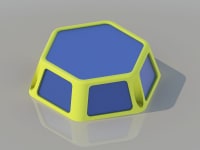This is a small, weather-proof electronic module covered by solar cells. Mounted on a surface or on a stake, it monitors the solar energy available over a long period of time to see if it’s practical to build a larger solar energy system in that location.
For some locations where solar power construction is proposed, such as open fields or unobstructed roofs in largely cloudless regions, simple analysis of sun angles through a season can give useful results for solar flux.
But there are many areas where shadowing objects and vegetation, uneven landscape, or irregular weather patterns make this more difficult, and this system is intended to fill that information gap.
The individual module is powered by a combination of its solar cells and batteries. There is a main top cell for power, and auxiliary cells pointing at various angles to get the complete pattern of exposure in different direction as the day progresses. Solid state memory collects the data.
After a selected period of time, preferably a full season, the information is uploaded wirelessly to a nearby cell phone or other device for later analysis to find the actual average solar flux at that location. This allows the unit to remain in place for further data gathering.
Data can be read at close range using standard wi-fi or Bluetooth technology. Unit power and location permitting, cell phone transmission could be used for longer-range data gathering. If there are settings to be made in the module, those are also done wirelessly. Each module has a serial number to identify it in the database.
Ideally, a number of modules would be mounted in a specific location to make sure the whole area is properly analyzed. On a multi-gabled roof for example, units should be placed facing different directions.
Mounting techniques are almost unlimited. The module can be screwed to a wall or roof, mounted with adhesives or structural Velcro, or set up on the end of stakes on the ground.
A more complicated module could take readings on other environmental factors, like rainfall or temperature, but it’s important that systems be minimized to keep unit costs low. If properly designed, the module should be almost disposable.
Like this entry?
-
About the Entrant
- Name:Tom Brosz
- Type of entry:individual
- Software used for this entry:Solidworks
- Patent status:none








